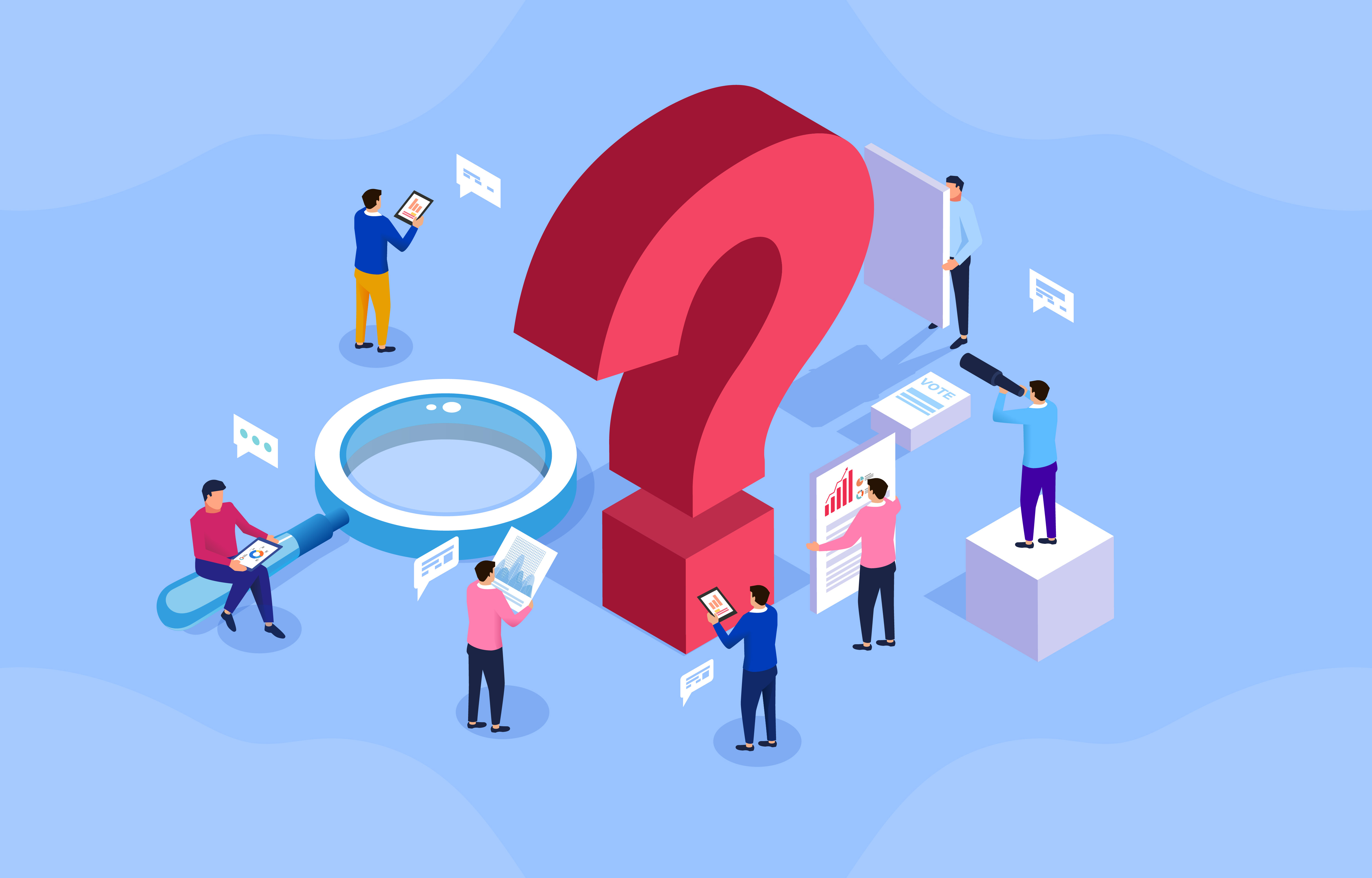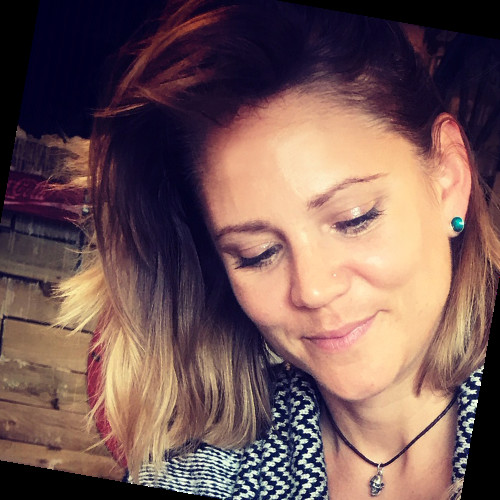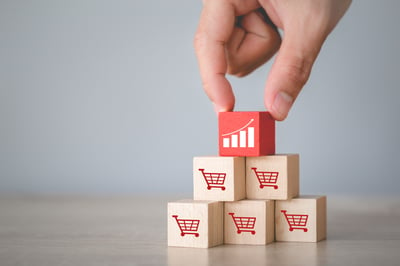November 15, 2019
 by Andy Mura / November 15, 2019
by Andy Mura / November 15, 2019

We’re living in an era characterized by an abundance of choice: car makes and models, phone contracts, laptops, coffee products...you name it, there is a choice for everything.
Software, as an industry, is definitely not an exception. For example, just take a look at how many CRM solutions are out there. Look at other categories and you’ll get a very similar picture.
So, how do you cut through the noise and make sure your potential customers see the value in your solution? How can you differentiate your product or service in such a way that your customers will want you to become the market leader?
It all comes down to a big decision you’ll have to make—and the analysis and preparation that comes before it.
The first step toward becoming a market leader is understanding the market cycle, who your competitors are, and what they are doing. Let’s take, for example, marketing software. This image depicts the evolution of the marketing technology landscape:
Pretty scary, huh? And the number of new SaaS solutions that enter the market every year is constantly increasing.
It might sound discouraging, but when you think about it, every industry is characterized by cycles, and fragmentation is the classic initial stage that determines the beginning of every new technology cycle. Then, when it reaches maturity, the market automatically separates the winners from the losers. Some participants move to the fringes by targeting niche markets, smaller players disappear, and promising solutions get acquired or integrated into other services.
As the recollection pool for mainstream solutions slowly downsizes, a handful of players dominate the market until new disruptors shuffle the cards once again with innovative solutions that revolutionize the sector with a much better product or destabilize it with a new product category (Slack, anyone?).
The problem every SaaS company seems to be facing in such a hyper-competitive market is connected to targeting, positioning, and messaging, but there is one more important aspect that leads to product differentiation: the big decision that determines all the other choices your company will make.
To truly understand what your big decision might look like, we’ll look at companies like Apple and Salesforce as examples to see what their big decisions were, and how this determined their true USP (unique selling proposition) and eventually led them to success.
But before getting there and coming up with a few ideas on how you can formulate and communicate your big decision, let’s make sure we establish some ground rules and cover the basics.
Your big decision is a radical choice that goes beyond your standard positioning. When you try to differentiate your product or service, you usually talk about market, features, personas, and benefits, but we want to go one level above.
Why? Because all your product characteristics and brand dimensions should be consistent and linked to a very specific choice that truly defines your approach and differentiates your brand.
When considering classic positioning, we usually start by selecting a specific geographic area we can or want to cover. In this specific area, we identify the segment we address with our solution.
We identify the problem we solve for this segment and create a first draft for our positioning statement by defining who we are, what problem we solve, how we solve it, and who we address.
In his popular TED talk on leadership, Simon Sinek explains how leaders inspire action by adding “why” to the mix, then creating messages that revolve around that question.
He asserts that great leaders first highlight why they’re doing something (i.e. what their beliefs are) to create a tribe of followers that cheers for them and is willing to support the cause. Sinek also cites Apple as an example to show how you can create fans by showing why you’re doing what you’re doing instead of simply presenting what you’re doing.
That’s probably why a lot of SaaS homepages nowadays present claims that start with, “We believe that/in...” It works! So you should definitely explain why you’re trying to solve the problem your solution is designed to tackle.
With a plain positioning statement, you can slowly start differentiating your solution from all other software solutions in your category. Then, you need to start thinking about your customer persona and competitors to define exactly who you want to address and what problem you solve for them—then explain why your solution is different.
By adding a few details, you move one step further in terms of differentiation with a classic value proposition. Take our theoretical marketing software company as an example:
|
Category: You offer marketing software (not a customer success tool) Segment: You sell a solution for startups and small companies (not enterprise customers) Product: You offer a marketing automation tool (not an influencer marketing tool) Purpose: You can automate the entire inbound funnel (not an outreach tool) Persona: Inbound marketing manager (not a performance marketing manager) Functionality: It’s a visual drag-and-drop funnel automation builder (not using rules and code) Benefit: Intuitive and fast (not a complex one-stop-shop product suite) Why: You believe that marketers need to spend more time creating personalized communication strategies (not focusing too much on setting up automation) |
Now that we’ve outlined a value proposition for your business, the next step is connected to your customer persona and your competitors.
To tailor a convincing value proposition for your target audience means you need to know them. This process starts with their profile and their goals.
|
Based on the answers, you’ll need to show how:
|
Once you explain this, you can create specific messages which, in turn, can also be linked to individual features. The messages will demonstrate how you achieve the objectives stated in your value proposition. This information basically represents a pretty nice outline for the messaging on your product landing page.
This value proposition process will not automatically differentiate your product from your competitors—after all, we all have access to the same technology, information, and resources. If you stop your journey at this stage, you’ll end up trying to sell your product based on its features and the problem you (and dozens of other competitors) are trying to solve.
A competitive advantage based on features and functionality is not sustainable because any competitors with more cash in the bank will always outrun you in the feature marathon. So, if you can’t outrun them, you’ll have to be the tortoise in the race and outsmart them.
In an equal playing field, companies must make an effort to outsmart their competitors with memorable messages. A great story and a great copy can be incredibly effective when selling a product.
For example, you can sell a vacuum cleaner by saying how powerful the engine is or how quiet it is. But a vacuum cleaner is a tool, and a pretty boring one at that. An Instagram video can prove how strong the vacuum cleaner is until a competitor releases a similar video in which they show how they outperform the product a couple of days later.
Vacuum cleaners are supposed to clean, but that’s not the actual outcome. The outcome of a great vacuum cleaner is a clean room in which babies and toddlers can crawl and play the whole day without dealing with allergies or getting in touch with nasty germs—an eternal battle between good and evil that has characterized every memorable story since the dawn of time!
This story might get you ahead of the competition because the message resonates with your target group or because your story is effective at explaining the true benefit of having a powerful vacuum cleaner.
After all, you don’t use a hammer to hit nails—you use it to build a perfect coffee table for your living room or hang the very first picture your child has painted. You don’t want to sell tools or features—you want to sell outcomes.
Present a better version of the person you address by showing the end-state in which they’re happier, richer, more serene, etc.
In software, emotions can go a long way too because you can always leverage atavic sentiments that are linked to hopes and expectations. However, we’re still talking about differentiating and optimizing your communications strategy, not your product.
Making a big decision the final step that leads powerful brands to differentiate their products or services from all other competitors. Apple and Salesforce are brands that exemplify the big decision, so let’s look at them as examples.
Why do so many people love to use Apple products? Is it because of the features? Not really. Apple’s competitors usually have more features and applications available to users. Is it performance? Well, despite having a great performance, Apple products are often outperformed by competitors in several areas. And pricing is certainly not a reason why some people choose Apple over their competitors
You might say that the overall user experience (UX) is better with Apple products and that’s their competitive advantage (along with great hardware design). Even the truest Google fans might have to agree with you on that.
Overall UX is a key factor that leads to product adoption. Especially if you compete against older solutions that still need to cope with legacy issues, you’ll probably have an intrinsic competitive advantage connected to your user experience.
However, a great UX for Apple is not the big decision the company made, but rather a by-product of it. A big decision is the one that determines all the other decisions your company makes. It is the one factor you can use to benchmark all your other decisions, and the one that determines all your features and the destiny of your brand.
The big decision, after all, needs to be bold and courageous. For Apple, this decision was to take a fully-integrated approach, which allowed the company to maintain full control over every aspect of the customer journey.
In a world in which Microsoft was creating software for multiple machines powered by Intel or AMD processors that ran dozens of third-party applications, Apple created its own software for its own machines that would run on its own OS.
Later on, Apple created its own mp3 players that would integrate with its store, and later a phone that would run its own OS and proprietary apps. Google took the opposite approach and made its mobile OS open source, welcoming app developers from around the world.
Apple’s awesome UX, smooth performance, sleek appearance, coherent looks, stability, and security were all by-products of the company’s radical big decision to create a fully-integrated approach. All the benefits and features that were derived from this approach were the result of a consistent vision.
Over time, Apple became less strict with its rules. Apple never lost its original vision but changed some directives to allow people to run Microsoft Office applications on Apple computers powered by Intel processors and opened the doors to several app creators in its store. Still, Apple stuck with its big decision and maintains maintain full control over every aspect of its products.
The CRM sector is dominated by giant players, but Salesforce decided to disrupt the market with its vision: software as a service. In a market in which hard disks were becoming cheaper and local servers were finally becoming affordable, Salesforce’s big decision was to offer a cloud-based CRM solution.
Salesforce’s big decision determined every aspect of its product and brand, from its logo to the features it offers. Five years later, the company reached unicorn status and its current market cap is a staggering $140 billion.
Tesla’s big decision was to put an electric engine in an expensive roadster at a time when electric cars were associated with the sensible (albeit boring) hybrid hipster hatchback.
Drift’s big decision was limiting its focus on enabling salespeople with a more human approach to a purely online sales process in a world of customer service chatbots.
Powerful brands always make uncomfortable and seemingly limiting decisions at some point. Every big decision is a bet—you might lose, but if you win, you win big. Companies can change their course of action based on new environmental conditions and making new bets.
It’s important to emphasize that a big decision is not your business idea or business model. While Airbnb’s solution to the problem of finding an accommodation is a complete disruption in the ecosystem—a totally new business model that flourished at the right time as the sharing economy was becoming a thing—the company had no competitors it needed to differentiate from.
In contrast, if you look at the examples presented above, you’ll notice a trend. Companies already had CRMs before Salesforce and people used to drive electric cars well before Tesla started selling a BEV version of a Lotus Elise.
Your big decision is what sets you apart from all other solutions in the same ecosystem. In a world dominated by vanilla ice cream, your bet is like offering french fry-flavored ice cream.
This decision defines your brand personality and provides guidelines for sales, marketing, product, and customer success. You need to take a stand—after all, the worst thing you can do is to offer flavorless ice cream or produce yet another slightly tastier vanilla ice cream people are already familiar with.
Now that you know how it’s done, It’s time to decide on your big decision and present it to the world. Start with some basic questions:
|
Determine the one big decision that can provide new value for your customer group despite what others are currently offering. Then, use that information to inform what you need to do to generate consistency in your brand:
|
Once you’ve done this, define the DNA of your brand by looking at all the attributes, features, emotional benefits, and values that allow your brand to justify the big decision you’re about to make. Create a short brand essence statement that encompasses the key aspects of your big decision.
Finally, when it comes to asking yourself why you selected this specific bet, use a five whys framework. Start by asking yourself why you went for a specific big decision and challenge the answer with another why. Take the answer and challenge it with another why. Repeat three more times until you get to the root cause of your big decision.
Now it’s time to get out there and show the world you’re different knowing that you’ll always be able to support and justify your decision and make coherent choices in its defense.
What will your big decision be? Whatever it is, make sure it’s risky. Mark Zuckerberg said it best: “The biggest risk is not taking any risk. In a world that is changing really quickly, the only strategy that is guaranteed to fail is not taking risks.”
G2's buyer intent data tool gives you insight into your buyer journey and brings you closer to your customers.
Product-led growth (PLG) is a go-to-market strategy that centers on the product.
 by Ioana Sima
by Ioana Sima
The road to bootstrapping a SaaS company is full of hurdles. But for product connoisseurs, it...
 by Ben Robinson
by Ben Robinson
The best conversations take place when time is limited.
 by Charlotte Powell
by Charlotte Powell
Product-led growth (PLG) is a go-to-market strategy that centers on the product.
 by Ioana Sima
by Ioana Sima
The road to bootstrapping a SaaS company is full of hurdles. But for product connoisseurs, it...
 by Ben Robinson
by Ben Robinson


